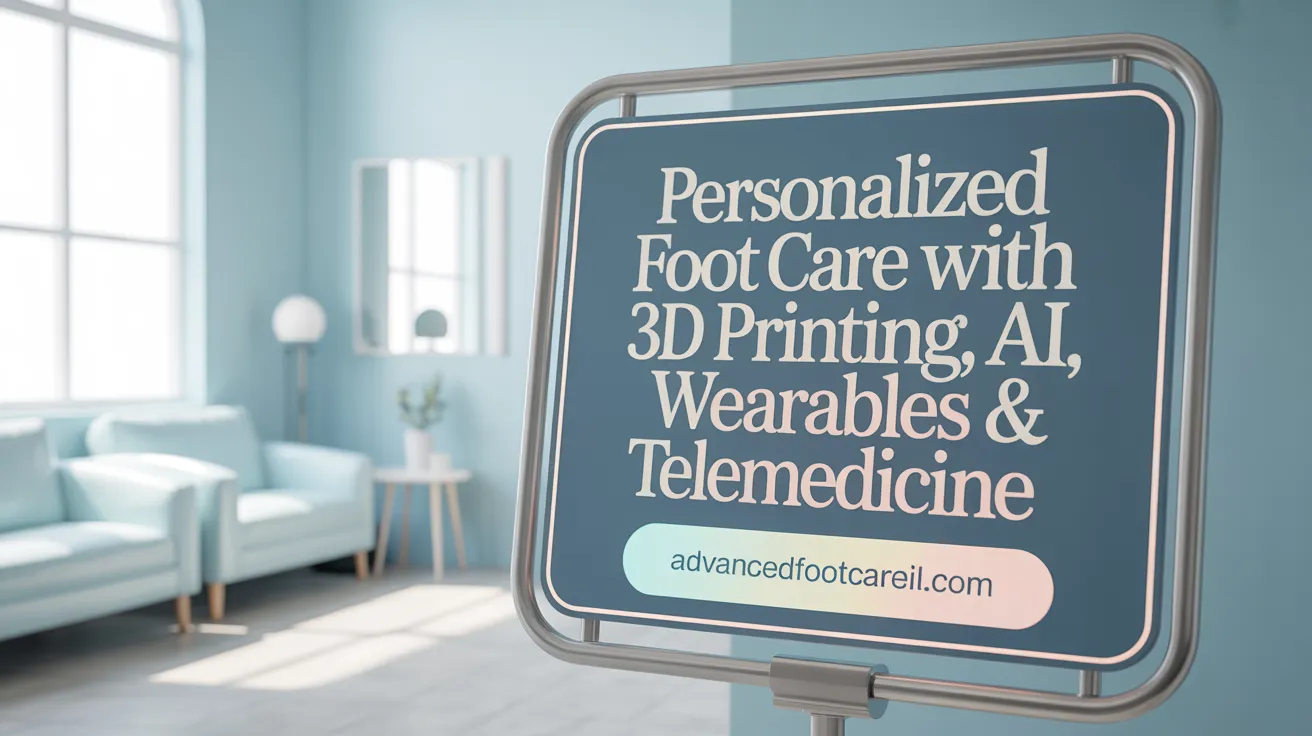Introduction to Modern Foot Health Innovations
Foot health is undergoing a transformative era fueled by technological advancements and innovative treatment modalities. From diagnostics to surgery and non-invasive therapies, the integration of tools like 3D printing, artificial intelligence, and regenerative medicine is reshaping podiatry. This article explores the cutting-edge solutions improving diagnosis, treatment, prevention, and patient outcomes in foot and ankle care today.
Advanced Diagnostics and Precision Surgical Techniques
 Recent advancements in foot and ankle care revolve around cutting-edge diagnostic imaging and minimally invasive surgical techniques that enhance patient outcomes.
Recent advancements in foot and ankle care revolve around cutting-edge diagnostic imaging and minimally invasive surgical techniques that enhance patient outcomes.
MRI and ultrasound imaging play a central role in this technological evolution. MRI scans provide detailed views of soft tissues such as tendons, ligaments, and muscles, enabling precise identification of injuries like tears or inflammation. Ultrasound imaging offers a quick, real-time, non-invasive method to visualize soft tissue conditions, guide injections, and assist in minimally invasive procedures.
To complement imaging, 3D scanning technology and weight-bearing CT scans now allow for comprehensive structural assessment of the foot and ankle. These tools generate highly accurate models of bone and soft tissue anatomy, critical for designing custom orthotics and planning surgical interventions with enhanced precision.
On the surgical front, minimally invasive procedures like endoscopic plantar fasciotomy and arthroscopy have transformed treatment strategies. These techniques involve smaller incisions, reduced tissue disruption, and faster recovery times. Endoscopic plantar fasciotomy, guided by real-time imaging, effectively relieves persistent heel pain.
Robotics further revolutionize surgical precision. Robotic-assisted systems such as the Mazor X™ facilitate complex procedures like bunion correction and ankle fusion with high accuracy, decreasing complication rates and improving recovery outcomes.
Laser surgery now offers targeted treatment options for conditions like ingrown toenails, warts, and fungal infections, minimizing tissue damage and discomfort.
Additionally, virtual reality technology is increasingly integrated into surgical planning and training. Surgeons utilize VR models to simulate procedures, enhance skills, and improve preoperative planning, ultimately leading to safer surgeries and better patient results.
Innovative Non-Surgical Therapies and Regenerative Medicine
 Emerging non-surgical treatment options are revolutionizing how foot problems are managed in 2024. Regenerative medicine therapies like platelet-rich plasma (PRP) and stem cell treatments are gaining popularity for their ability to promote natural tissue healing and reduce pain in conditions such as plantar fasciitis, Achilles tendinitis, and diabetic foot ulcers.
Emerging non-surgical treatment options are revolutionizing how foot problems are managed in 2024. Regenerative medicine therapies like platelet-rich plasma (PRP) and stem cell treatments are gaining popularity for their ability to promote natural tissue healing and reduce pain in conditions such as plantar fasciitis, Achilles tendinitis, and diabetic foot ulcers.
Extracorporeal Shockwave Therapy (ESWT) is another breakthrough, utilizing acoustic waves to stimulate tissue repair and improve blood flow. It offers a non-invasive alternative to surgery, especially effective for chronic issues like plantar fasciitis.
MLS laser therapy is a cutting-edge, FDA-cleared treatment that uses specific wavelengths of light to accelerate healing, decrease inflammation, and alleviate pain in various foot ailments. Its quick sessions with no downtime make it a preferred option for many patients.
For stubborn plantar warts, swift microwave therapy is a promising new approach. It activates the immune system through sound waves, effectively clearing the virus without wounds or discomfort.
Physical therapy now incorporates modern technology such as ultrasound and electrical stimulation, enhancing the recovery process and helping prevent future injuries.
In addition, new injection therapies involving steroids, hyaluronic acid, or botulinum toxin are used to provide relief for chronic foot pain and reduce reliance on invasive procedures. These therapies not only ease symptoms but can also delay or eliminate the need for surgery (source).
More info on these advancements can be found by searching for "regenerative medicine and non-surgical therapies in podiatry 2024." These innovations underscore a shift towards less invasive, more effective treatments that improve patient comfort and recovery.
Technological Innovations Enhancing Customization and Monitoring
 Recent technological advancements are revolutionizing foot care by making it more personalized, proactive, and accessible.
Recent technological advancements are revolutionizing foot care by making it more personalized, proactive, and accessible.
One of the most significant innovations is 3D printing custom orthotics, which allows podiatrists to create custom orthotics and insoles that perfectly match the contours of an individual’s feet. This precision improves comfort, support, and biomechanical correction, leading to better treatment outcomes.
AI diagnostics have become a powerful tool for early detection and accurate diagnosis of foot conditions. By analyzing medical images, gait patterns, and patient histories, AI algorithms help identify issues like flat feet, diabetic neuropathy, or bunions more quickly than traditional methods. This early detection enables timely intervention, potentially preventing worsening of conditions.
Wearable technology, such as smart insoles equipped with sensors, continuously monitors foot pressure, stride, and gait in real time. For patients with chronic issues, especially diabetics, these devices provide valuable data to prevent ulcers and other complications. They also give insights into posture and movement, helping individuals optimize their walking habits.
Telemedicine has expanded access to expert foot care beyond clinic walls. Virtual consultations and remote diagnostics ensure patients in underserved areas can receive timely advice and treatment plans. This digital approach is particularly important in managing ongoing conditions and routine checkups.
Finally, digital health platforms for diabetic foot monitoring, like remote imaging scales and cloud-based data sharing, enable continuous observation of foot health. Patients can regularly upload images or data from home, allowing healthcare providers to detect early signs of ulcers or other issues without frequent in-person visits.
These innovations collectively facilitate a shift from reactive to preventive foot care. They empower patients with real-time insights, enable clinicians to make more informed decisions, and significantly improve the quality of life for individuals with foot health concerns.
Innovations in Wound Care and Advanced Medical Products
Recent advancements in wound care and regenerative medicine are transforming foot health management. One of the most notable approaches involves bioengineered skin substitutes, such as placental grafts like Matrion, which contain rich layers of growth factors to promote rapid healing of complex wounds like diabetic ulcers. These grafts provide a natural scaffold that supports new tissue growth and helps prevent infections.
In addition, topical gels have become an essential part of modern wound healing. Products like Excellagen, a collagen-based gel, activate platelet-derived growth factors to accelerate tissue repair, while non-pharmaceutical options like Nuvail, a polymer topical agent, help improve the appearance of dystrophic nails and control onychomycosis.
FDA-approved bandages are making wound management easier, especially for patients with limited mobility. Pedilay Med’s secondary bandages are designed for support and protection, simplifying wound dressing and reducing discomfort.
Laser therapies are now routinely used to treat fungal infections of the nails, providing non-invasive, painless solutions that deliver targeted light energy to eradicate fungi quickly. Complementing these treatments, regenerative medicine techniques such as platelet-rich plasma (PRP) and stem cell therapies are being increasingly employed to reduce inflammation, stimulate tissue regeneration, and improve healing outcomes.
These innovative modalities not only help in faster recovery but also significantly improve quality of life for patients dealing with lingering or complicated foot wounds. Moreover, the application of bioengineered tissues and advanced biological therapies plays a vital role in managing chronic wounds, especially in diabetic patients, thereby reducing the risk of amputations and promoting long-term foot health.
For further information, search for "advanced diabetic foot wound care and regenerative medicine."
Future Directions: Trends Shaping Foot and Ankle Care in 2024 and Beyond
How will upcoming technological trends and industry developments impact foot and ankle care in 2024 and beyond?
The future of podiatry is set to transform significantly with several advancing technologies. Artificial intelligence (AI) and machine learning are becoming central to diagnostics, allowing for highly accurate early detection of foot conditions such as deformities, infections, and neuropathies. AI-driven analysis of medical images, gait patterns, and patient history enables personalized treatment plans that are more precise than ever before.
Expansion of telemedicine will continue, making foot and ankle care more accessible, especially for patients in remote or underserved areas. Virtual consultations are evolving to include immersive features, enabling detailed assessments and patient education, which enhances compliance and engagement.
Virtual reality (VR) is emerging as a tool for pain management and rehabilitation. It offers immersive environments for therapy sessions, helping patients retrain neural pathways and improve mobility with minimal discomfort.
Wearable technology and smart devices—like sensor-equipped insoles and foot pressure monitors—will facilitate ongoing health monitoring outside the clinic. These tools provide real-time feedback on gait, pressure distribution, and motion patterns, allowing earlier intervention and better management of chronic conditions.
Sustainable and eco-friendly materials are gaining importance in foot care products, with biodegradable insoles and ethically sourced orthotics reducing the environmental footprint of manufacturing processes.
Finally, treatments will become increasingly personalized, combining regenerative medicine, advanced imaging, and data analytics. Preventive strategies will focus on early detection, lifestyle modifications, and customized orthotics, which together aim to lower the incidence of severe foot and ankle issues.
Overall, these technological advancements will lead to a shift towards more preventative, precise, and patient-centered care, improving outcomes and accessibility well into the future.
Conclusion: Embracing Innovation for Healthier Feet
The fusion of advanced technologies and innovative treatment modalities is revolutionizing foot and ankle health, delivering unprecedented levels of precision, personalization, and efficacy. From cutting-edge diagnostics and minimally invasive surgeries to regenerative therapies and intelligent monitoring devices, the landscape of podiatry is rapidly evolving to meet diverse patient needs. As technological trends continue to unfold, they promise to enhance accessibility, reduce recovery times, and improve the overall quality of life for individuals suffering from foot-related conditions. Embracing these innovations today paves the way to healthier, more mobile futures for patients worldwide.
